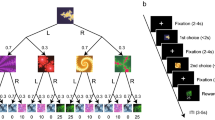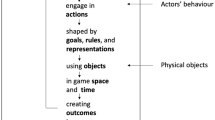Abstract
Predicting the behaviour of others is an essential part of social cognition. Despite its ubiquity, social prediction poses a poorly understood generalization problem: we cannot assume that others will repeat past behaviour in new settings or that their future actions are entirely unrelated to the past. We demonstrate that humans solve this challenge using a structure learning mechanism that uncovers other people’s latent, unobservable motives, such as greed and risk aversion. In four studies, participants (N = 501) predicted other players’ decisions across four economic games, each with different social tensions (for example, Prisoner’s Dilemma and Stag Hunt). Participants achieved accurate social prediction by learning the stable motivational structure underlying a player’s changing actions across games. This motive-based abstraction enabled participants to attend to information diagnostic of the player’s next move and disregard irrelevant contextual cues. Participants who successfully learned another’s motives were more strategic in a subsequent competitive interaction with that player in entirely new contexts, reflecting that social structure learning supports adaptive social behaviour.
This is a preview of subscription content, access via your institution
Access options
Access Nature and 54 other Nature Portfolio journals
Get Nature+, our best-value online-access subscription
$29.99 / 30 days
cancel any time
Subscribe to this journal
Receive 12 digital issues and online access to articles
$119.00 per year
only $9.92 per issue
Buy this article
- Purchase on Springer Link
- Instant access to full article PDF
Prices may be subject to local taxes which are calculated during checkout





Similar content being viewed by others
Data availability
The behavioural data analysed in this paper are available at https://github.com/jeroenvanbaar/NHB_motives_structure.
Code availability
The analysis code for this paper is available at https://github.com/jeroenvanbaar/NHB_motives_structure.
References
Stewart, A. J. et al. Information gerrymandering and undemocratic decisions. Nature 573, 117–121 (2019).
Hauser, O. P., Rand, D. G., Peysakhovich, A. & Nowak, M. A. Cooperating with the future. Nature 511, 220–223 (2014).
Fraser, C., Riley, S., Anderson, R. M. & Ferguson, N. M. Factors that make an infectious disease outbreak controllable. Proc. Natl Acad. Sci. USA 101, 6146–6151 (2004).
Tenenbaum, J. B., Kemp, C., Griffiths, T. L. & Goodman, N. D. How to grow a mind: statistics, structure, and abstraction. Science 331, 1279–1285 (2011).
Seuntjens, T. G., Zeelenberg, M., Van De Ven, N. & Breugelmans, S. M. Dispositional greed. J. Pers. Soc. Psychol. 108, 917–933 (2015).
Fehr, E. & Schmidt, K. M. A theory of fairness, competition, and cooperation. Q. J. Econ. 114, 817–868 (1999).
Bolton, G. & Ockenfels, A. ERC: a theory of equity, reciprocity, and competition. Am. Econ. Rev. 90, 166–193 (2000).
Weber, E. U., Blais, A.-R. & Betz, N. E. A domain-specific risk-attitude scale: measuring risk perceptions and risk behaviors. J. Behav. Decis. Mak. 15, 263–290 (2002).
Kahneman, D. & Tversky, A. Prospect theory: an analysis of decision under risk. Econometrica 47, 263–292 (1979).
Peysakhovich, A., Nowak, M. A. & Rand, D. G. Humans display a ‘cooperative phenotype’ that is domain general and temporally stable. Nat. Commun. 5, 4939 (2014).
Van Lange, P. A. M. The pursuit of joint outcomes and equality in outcomes: an integrative model of social value orientation. J. Pers. Soc. Psychol. 77, 337–349 (1999).
van Baar, J. M., Chang, L. J. & Sanfey, A. G. The computational and neural substrates of moral strategies in social decision-making. Nat. Commun. 10, 1483 (2019).
Poncela-Casasnovas, J. et al. Humans display a reduced set of consistent behavioral phenotypes in dyadic games. Sci. Adv. 2, e1600451 (2016).
van Baar, J. M., Klaassen, F. H., Ricci, F., Chang, L. J. & Sanfey, A. G. Stable distribution of reciprocity motives in a population. Sci. Rep. 10, 18164 (2020).
Jara-Ettinger, J. Theory of mind as inverse reinforcement learning. Curr. Opin. Behav. Sci. 29, 105–110 (2019).
Bridgers, S., Jara-Ettinger, J. & Gweon, H. Young children consider the expected utility of others’ learning to decide what to teach. Nat. Hum. Behav. https://doi.org/10.1038/s41562-019-0748-6 (2019).
Liu, S., Ullman, T. D., Tenenbaum, J. B. & Spelke, E. S. Ten-month-old infants infer the value of goals from the costs of actions. Science 358, 1038–1041 (2017).
Baker, C. L., Saxe, R. & Tenenbaum, J. B. Action understanding as inverse planning. Cognition 113, 329–349 (2009).
Baker, C. L., Jara-Ettinger, J., Saxe, R. & Tenenbaum, J. B. Rational quantitative attribution of beliefs, desires and percepts in human mentalizing. Nat. Hum. Behav. 1, 0064 (2017).
Nihonsugi, T., Ihara, A. & Haruno, M. Selective increase of intention-based economic decisions by noninvasive brain stimulation to the dorsolateral prefrontal cortex. J. Neurosci. 35, 3412–3419 (2015).
Wedekind, C. & Milinski, M. Cooperation through image scoring in humans. Science 288, 850–852 (2000).
Harbaugh, W. T., Mayr, U. & Burghart, D. R. Neural responses to taxation and voluntary giving reveal motives for charitable donations. Science 316, 1622–1625 (2007).
Niv, Y. et al. Reinforcement learning in multidimensional environments relies on attention mechanisms. J. Neurosci. 35, 8145–8157 (2015).
Radulescu, A., Niv, Y. & Ballard, I. Holistic reinforcement learning: the role of structure and attention. Trends Cogn. Sci. 23, 278–292 (2019).
Leong, Y. C., Radulescu, A., Daniel, R., Dewoskin, V. & Niv, Y. Dynamic interaction between reinforcement learning and attention in multidimensional environments. Neuron 93, 451–463 (2017).
Collins, A. G. E. & Frank, M. J. Neural signature of hierarchically structured expectations predicts clustering and transfer of rule sets in reinforcement learning. Cognition 152, 160–169 (2016).
Schapiro, A. C., Rogers, T. T., Cordova, N. I., Turk-Browne, N. B. & Botvinick, M. M. Neural representations of events arise from temporal community structure. Nat. Neurosci. 16, 486–492 (2013).
Wilson, R. C. & Niv, Y. Inferring relevance in a changing world. Front. Hum. Neurosci. 5, 189 (2012).
Schapiro, A. C., Turk-Browne, N. B., Norman, K. A. & Botvinick, M. M. Statistical learning of temporal community structure in the hippocampus. Hippocampus 26, 3–8 (2016).
Gershman, S. J. & Niv, Y. Learning latent structure: carving nature at its joints. Curr. Opin. Neurobiol. 20, 251–256 (2010).
Kemp, C. & Tenenbaum, J. B. The discovery of structural form. Proc. Natl Acad. Sci. USA 105, 10687–10692 (2008).
Heckathorn, D. D. The dynamics and dilemmas of collective action. Am. Sociol. Rev. 61, 250–277 (1996).
Axelrod, R. Effective choice in the prisoner’ s dilemma. J. Conflict Resolut. 24, 3–25 (1980).
Fehr, E. & Fischbacher, U. Social norms and human cooperation. Trends Cogn. Sci. 8, 185–190 (2004).
Goeree, J. K., Holt, C. A. & Palfrey, T. R. Risk averse behavior in generalized matching pennies games. Games Econ. Behav. 45, 97–113 (2003).
Bernoulli, D. Exposition of a new theory on the measurement of risk. Econometrica 22, 23–36 (1954).
Huygens, C. The Value of All Chances in Games of Fortune (Woodward, 1714).
Schwarz, G. Estimating the dimension of a model. Ann. Stat. 6, 461–464 (1978).
Hampton, A. N., Bossaerts, P. & O’Doherty, J. P. Neural correlates of mentalizing-related computations during strategic interactions in humans. Proc. Natl Acad. Sci. USA 105, 6741–6746 (2008).
Nosenzo, D., Offerman, T., Sefton, M. & Van Der Veen, A. Discretionary sanctions and rewards in the repeated inspection game. Manage. Sci. 62, 502–517 (2016).
FeldmanHall, O. & Shenhav, A. Resolving uncertainty in a social world. Nat. Hum. Behav. 3, 426–435 (2019).
Gershman, S. J., Pouncy, H. T. & Gweon, H. Learning the structure of social influence. Cogn. Sci. 41, 545–575 (2017).
Shin, Y. S. & Niv, Y. Biased evaluations emerge from inferring hidden causes. Nat. Hum. Behav. 5, 1180–1189 (2021).
Lau, T., Pouncy, H. T., Gershman, S. J. & Cikara, M. Discovering social groups via latent structure learning. J. Exp. Psychol. Gen. 147, 1881–1891 (2018).
Jara-Ettinger, J. Theory of mind as inverse reinforcement learning. Curr. Opin. Behav. Sci. 29, 105–110 (2019).
Collette, S., Pauli, W. M., Bossaerts, P. & O’Doherty, J. Neural computations underlying inverse reinforcement learning in the human brain. eLife 6, e29718 (2017).
Gobet, F. et al. Chunking mechanisms in human learning. Trends Cogn. Sci. 5, 236–243 (2001).
Thalmann, M., Souza, A. S. & Oberauer, K. How does chunking help working memory? J. Exp. Psychol. Learn. Mem. Cogn. 45, 37–55 (2019).
Johnson, E. J., Camerer, C., Sen, S. & Rymon, T. Detecting failures of backward induction: monitoring information search in sequential bargaining. J. Econ. Theory 104, 16–47 (2002).
Nagel, R. Unraveling in guessing games: an experimental study. Am. Econ. Rev. 85, 1313–1326 (1995).
Rapoport, A. Individual strategies in a market entry game. Group Decis. Negot. 4, 117–133 (1995).
Kollock, P. Social dilemmas: the anatomy of cooperation. Annu. Rev. Sociol. 24, 183–214 (1998).
Fischbacher, U., Gächter, S. & Fehr, E. Are people conditionally cooperative? Evidence from a public goods experiment. Econ. Lett. 71, 397–404 (2001).
Kurzban, R. & Houser, D. Experiments investigating cooperative types in humans: a complement to evolutionary theory and simulations. Proc. Natl Acad. Sci. USA 102, 1803–1807 (2005).
Moore, T. & Zirnsak, M. Neural mechanisms of selective visual attention. Annu. Rev. Psychol. 68, 47–72 (2017).
Caprariello, P. A., Cuddy, A. J. C. & Fiske, S. T. Social structure shapes cultural stereotypes and emotions: a causal test of the stereotype content model. Group Process. Intergroup Relat. 12, 147–155 (2009).
McCauley, C., Stitt, C. L. & Segal, M. Stereotyping: from prejudice to prediction. Psychol. Bull. 87, 195–208 (1980).
Nickerson, R. S. Confirmation bias: a ubiquitous phenomenon in many guises. Rev. Gen. Psychol. 2, 175–220 (1998).
Pierson, E. et al. A large-scale analysis of racial disparities in police stops across the United States. Nat. Hum. Behav. https://doi.org/10.1016/j.athoracsur.2014.09.078 (2020).
Gureckis, T. M. et al. psiTurk: an open-source framework for conducting replicable behavioral experiments online. Behav. Res. Methods 48, 829–842 (2016).
Licht, A. N. Games commissions play: 2 × 2 games of international securities regulation. Yale J. Int. Law 24, 61–125 (1999).
Bramoullé, Y. Anti-coordination and social interactions. Games Econ. Behav. 58, 30–49 (2007).
Skyrms, B. The Stag Hunt. Proc. Addresses Am. Phil. Assoc. 75, 31–41 (2001).
Von Neumann, J. & Morgenstern, O. Theory of Games and Economic Behavior (Princeton Univ. Press, 1944).
Harris, C. R. et al. Array programming with NumPy. Nature 585, 357–362 (2020).
McKinney, W. Data structures for statistical computing in Python. In Proc. 9th Python in Science Conf. (eds van der Walt, S. & Millman, J.) 56–61 (2010).
Virtanen, P. et al. SciPy 1.0: fundamental algorithms for scientific computing in Python. Nat. Methods 17, 261–272 (2020).
Hunter, J. D. Matplotlib: a 2D graphics environment. Comput. Sci. Engineer. 9, 90–95 (2007).
Waskom, M. seaborn: statistical data visualization. J. Open Source Softw. 6, 3021 (2021).
Mueller, A. WordCloud for Python documentation, https://amueller.github.io/word_cloud/ (2020).
Bates, D., Mächler, M., Bolker, B. & Walker, S. Fitting linear mixed-effects models using lme4. J. Stat. Softw. 67, 1–48 (2015).
Kuznetsova, A., Brockhoff, P. B. & Christensen, R. H. B. lmerTest package: tests in linear mixed effects models. J. Stat. Softw. 82, 1–26 (2017).
Acknowledgements
We thank A. Sánchez for sharing experimental data from ref. 13. This work was funded by NIH Centers of Biomedical Research Excellence grant no. P20GM103645 (to O.F.H). The funder had no role in study design, data collection and analysis, decision to publish or preparation of the manuscript.
Author information
Authors and Affiliations
Contributions
J.M.v.B. and O.F.H designed the research. J.M.v.B. and W.D. performed the research. J.M.v.B., M.R.N. and O.F.H analysed the data. J.M.v.B. and O.F.H wrote the paper. J.M.v.B., M.R.N. and O.F.H edited the manuscript.
Corresponding author
Ethics declarations
Competing interests
The authors declare no competing interests.
Additional information
Peer review information Nature Human Behaviour thanks Björn Lindström, David Sander and the other, anonymous, reviewer(s) for their contribution to the peer review of this work. Peer reviewer reports are available.
Publisher’s note Springer Nature remains neutral with regard to jurisdictional claims in published maps and institutional affiliations.
Supplementary information
Supplementary Information
Supplementary Figs. 1–3, Results 1–9 (including Figs. 4–9), Text 1 and References.
Rights and permissions
About this article
Cite this article
van Baar, J.M., Nassar, M.R., Deng, W. et al. Latent motives guide structure learning during adaptive social choice. Nat Hum Behav 6, 404–414 (2022). https://doi.org/10.1038/s41562-021-01207-4
Received:
Accepted:
Published:
Issue Date:
DOI: https://doi.org/10.1038/s41562-021-01207-4
This article is cited by
-
How inferred motives shape moral judgements
Nature Reviews Psychology (2022)



